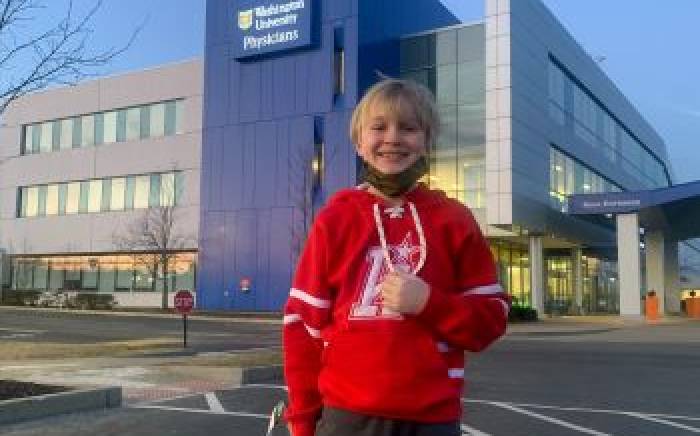Your child has had a fever for two days. Suddenly, his body stiffens and then his arms and legs begin jerking. Afterward, he’s exhausted. What just happened? It’s likely he had a seizure.
What To Do in Case of a Seizure
“There’s not much you can do to stop a seizure so I tell parents to stay calm and make sure their child is safe,” K. Liu Lin Thio, MD, pediatric neurologist and director of the Pediatric Epilepsy Center at St. Louis Children’s Hospital says. “Turn the child on the left side in case they vomit and don’t try to place anything in the child’s mouth. It’s impossible for a child to swallow his tongue so don’t worry about that.”
A seizure typically lasts less than five minutes. If a seizure lasts longer than that, call 911, Dr. Thio advises.
What Type of Seizure Was It?
In the example above, the seizure was most likely a febrile seizure which is a type of seizure associated with fever. Seizures come in a variety of sizes and severity with different causes. The causes of acute seizures are varied and include fever, electrolyte abnormalities, brain trauma, or infections around the brain such as meningitis or encephalitis. A fever can be one cause for kids younger than 5.
“About 10 percent of people will have at least one seizure in their lifetime and febrile seizures are the most common type in childhood,” Dr. Thio. “The prognosis for a febrile seizure is good; kids don’t usually have any lasting problems. However, one-third of kids with febrile seizures will have another.”
A seizure frightens most parents who worry their child has epilepsy. “The risk of an otherwise healthy child developing epilepsy is only 2 to 3%. But still, 95 percent of kids will not develop epilepsy.”
Is It Epilepsy?
Most people associate seizures with epilepsy, which is a neurological condition that makes people more susceptible to seizures. An abnormal electrical discharge in the brain results in a seizure. Epilepsy in children is usually caused by genetics or a prior injury to the brain from head trauma, infection around the brain, or stroke.
When a child has two or more unprovoked seizures, he is considered to have epilepsy. More than 3 million Americans have epilepsy.
Seizures aren’t always dramatic or noticeable. Sometimes a child may just have a brief spell of staring, eye blinking, or arm numbness. Other seizures aren’t so subtle and may result in loss of consciousness or jerking movements. “A seizure isn’t defined by what it looks like, but rather what happens in the brain,” Dr. Thio says. “We become more suspicious of epilepsy if someone has stereotypical spells that cause them to do things out of their control repeatedly.”
Often, children aren’t diagnosed with epilepsy until they have a more dramatic seizure. In the mean time, they may have been having less noticeable seizures, Dr. Thio adds.
The good news? “In kids, if we can’t identify a cause, it’s likely genetic and it’s possible that a child may outgrow epilepsy.” Dr. Thio says.
Treatment for Epilepsy
The Pediatric Epilepsy Center at St. Louis Children’s Hospital provides a full spectrum of treatment. Part of the Center includes New Onset Seizure Clinic, which offers an evaluation within 24 to 48 hours of a child’s first seizure. If it’s the first time your child has had a seizure — no matter what the assumed cause — have your child evaluated.
Treatment options include:
Medication. The first line of treatment is medication, which controls seizures in 70 percent of children and adults.
Surgery. For the remaining 30 percent who don’t respond to medication, epilepsy surgery is an option. Even very young children may be candidates for surgery. Patients are carefully evaluated and physicians discuss each patient at an Epilepsy Surgery Conference to recommend the next treatment step.
Diet. Another option is a dietitian-supervised ketogenic diet through the Ketogenic Clinic. The ketogenic diet is high-fat, low-carbohydrate with adequate protein that has been shown to reduce the frequency of seizures in some children.
Vagus nerve stimulation. Vagus nerve stimulation (VNS) involves implanting a pacemaker-like device in the chest wall. VNS attempts to control seizures by sending small pulses of energy to the brain through the vagus nerve, which is a large nerve in the neck. It can lessen the frequency of seizures and shorten the episodes.
Clinical trials. Because St. Louis Children’s is affiliated with Washington University School of Medicine, patients can participate in clinical trials, which gives them access to the latest treatments for epilepsy.
“Our goal with epilepsy treatment is to help kids live a normal life,” Dr. Thio explains. “We encourage parents to treat their children the same as they did before the seizures started and to have the same expectations, such as getting a job, getting married and having children.”










